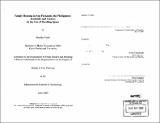| dc.contributor.advisor | Anna Hardman. | en_US |
| dc.contributor.author | Niimi, Masako, 1966- | en_US |
| dc.contributor.other | Massachusetts Institute of Technology. Dept. of Urban Studies and Planning. | en_US |
| dc.coverage.spatial | a-ph--- | en_US |
| dc.date.accessioned | 2012-02-29T17:26:21Z | |
| dc.date.available | 2012-02-29T17:26:21Z | |
| dc.date.copyright | 2000 | en_US |
| dc.date.issued | 2000 | en_US |
| dc.identifier.uri | http://hdl.handle.net/1721.1/69425 | |
| dc.description | Thesis (M.C.P.)--Massachusetts Institute of Technology, Dept. of Urban Studies and Planning, 2000. | en_US |
| dc.description | Includes bibliographical references (p. 67). | en_US |
| dc.description.abstract | Households make decisions on housing based on their budgets, preferences, and the family lifecycle. The outcomes we observe are very diverse. This thesis explores the causes and effects of these heterogeneous housing choices by looking at family characteristics including income, occupations, and ages of family -members. It looks at outcomes by examining floor plans of the houses they build and alter over time. Housing choices are explored in terms of four major issues: crowding, tenure rights, time (time-span in a house and house owners' age), and home-based enterprises (HBEs). The study was carried out at two sites in San Fernando, the Philippines: a government relocation settlement and an informal squatter settlement. This study shows how family needs and values produce a variety of housing decisions in both the resettlement and squatter sites. The data show how the residents' housing choices reflect their limited economic resources and different personal and tenure security needs and preferences. In these two survey sites, many factors enter into the tradeoffs households make, including land title, household size, plot size (and the uniform plot design in the resettlement site), and a desire for personal security against natural disasters. In this study we see how households can utilize their dwellings for small business activities to gain income with little risk: some families surveyed, especially in the resettlement site, had created thriving HBEs. Thus mixed land-use in the residential site can help families survive the uncertain economic conditions such as families often face in resettlement. I argue that this should be incorporated in future housing policies. Settlers build a variety of housing types: squatter shanties, shacks expanded into sturdy two-story dwellings, houses with businesses. The numerous and sometimes unrelated variables which determine their choices can make it difficult for planners and government officials who depend on statistics to formulate solutions. However, the outcomes we observe reflect how families adapt to their environment to sustain themselves with limited resources. Above all, planners need first to examine the reality of a neighborhood and then to make room for households' heterogeneous choices and tradeoffs in their plans. | en_US |
| dc.description.statementofresponsibility | by Masako Niimi. | en_US |
| dc.format.extent | 120 p. | en_US |
| dc.language.iso | eng | en_US |
| dc.publisher | Massachusetts Institute of Technology | en_US |
| dc.rights | M.I.T. theses are protected by
copyright. They may be viewed from this source for any purpose, but
reproduction or distribution in any format is prohibited without written
permission. See provided URL for inquiries about permission. | en_US |
| dc.rights.uri | http://dspace.mit.edu/handle/1721.1/7582 | en_US |
| dc.subject | Urban Studies and Planning. | en_US |
| dc.title | Family housing in San Fernando, the Philippines : tradeoffs and choices in the use of dwelling space | en_US |
| dc.type | Thesis | en_US |
| dc.description.degree | M.C.P. | en_US |
| dc.contributor.department | Massachusetts Institute of Technology. Department of Urban Studies and Planning | |
| dc.identifier.oclc | 47917092 | en_US |
